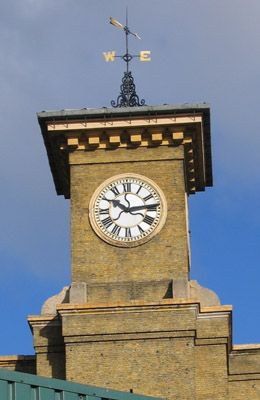clock puzzles

The clock on Kings Cross Station clock tower, London.
The earliest known clock problem was posed in 1694 by Jacques Ozanam in his Récréations mathématiques et physiques.
Here are two clock puzzles invented by Lewis Carroll:
1. A clock has hour and minute hands of the same length and no numerals on its face. At what time between 6 and 7 o'clock will the time on the clock appear to be the same as the time read on the reflection of the clock in a mirror?
2. Which has a better chance of giving the right time: a clock that has stopped or one that loses a minute every day?
And here is another from Henry Dudeney's Amusements in Mathematics called "The Club Clock:"
3. One of the big clocks in the Cogitators' Club was found the other night to have stopped just when, as will be seen in the illustration, the second hand was exactly midway between the other two hands. One of the members proposed to some of his friends that they should tell him the exact time when (if the clock had not stopped) the second hand would next again have been midway between the minute hand and the hour hand. Can you find the correct time that it would happen?
Solutions
1. Approximately 27 minutes and 42 seconds (exactly 360/13 minutes) after 6.
2. The stopped clock, because it will give the right time twice a day whereas the other is only correct about every two years approximately.
3. The positions of the hands shown in the illustration could only indicate that the clock stopped at 44 minutes 51 1143/1427 second after eleven o'clock. The second hand would next be "exactly midway between the other two hands" at 45 minutes 52 496/1427 second after eleven o'clock. If we had been dealing with the points on the circle to which the three hands are directed, the answer would be 45 minutes 22 106/1427 second after eleven; but the question applied to the hands, and the second hand would not be between the others at that time, but outside them.


